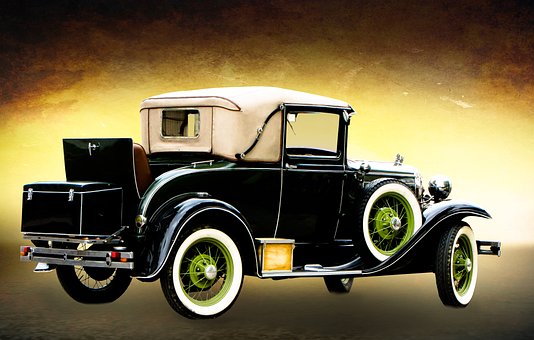 As I grew up, I heard stories from grandparents and others in their generation about the fun things they did to others in Model A's and other cars of that vintage.
As I grew up, I heard stories from grandparents and others in their generation about the fun things they did to others in Model A's and other cars of that vintage. One relative told me they'd have fun with new drivers when he was young. One of them would sit right next to the driver so he'd be by the gear shift. When the driver stopped at a stop sign, the person would carefully pull up the gear shift and disengage it. When the driver wanted to start up again, they could shift.
Another time, I was told that when the Pali on Oahu was brand new, it went up the side of the mountain. He said cars had to back up the Pali because those early cars did not have a gas pump and if they went up the normal way, gas would not flow into the engine. I also remember hearing about two cars in Ohio in 1912 who managed to run into each other.
Did you know the first car came out in 1769 with a steam powered engine but the first gas powered internal combustion engine made its appearance in 1807 but commercial production was not to happen until 1886 when Karl Benz designed a car with four wire rim wheels and a four stroke engine in the rear. Benz is considered the inventor of modern cars because his produced its own power and he received the patent for it. The first cars produced used a lever instead of a steering wheel so the driver was operating the car basically using a joy stick.
Rolls-Royce, established in 1906, produced its very first car the Silver Ghost the same year. One year later, the Silver Ghost set a record for going 24,000 kilometers during a series of reliability tests. By 1916, the Model-T Ford made up 55 percent of the cars in the world. This record is still unbroken. Side note: Henry Ford used to repair watches when he was younger using tools he made. Even Hitler got into the car game when he ordered the Volkswagon (people's car) be produced in Germany beginning in the 1930's.
The thing about the early Benz and Rolls-Royce cars is that each one was manufactured individually so they were only afforded by the wealthy. Henry Ford changed this when he devised a method of mass production due to a lack of skilled workers and having access to cheap raw materials. In addition, there was a lack of tariffs among states providing a larger area for sales and the mass produced method produced cheaper and more consistent product. By 1913, Ford produced about two-thirds of all the automobiles produced world wide. The rest is history.
Now for the fun facts.
1. The first steam powered engine produced in 1769, weighed over 8000 pounds and was used to move cannons.
2. The worlds first speeding ticket was issued in 1904 in Dayton, Ohio. The driver was speeding along at 12 mph.
3. Most American cars beep in the key of F.
4. Motorola tried to develop a record player for cars but ended up producing the first radio. The name Motorola comes from Motorcar + sound.
5. When Al Capone was convicted of tax evasion, the government seized his armor plated limo. The day after Pearl Harbor was bombed, President Roosevelt rode in this same limo to congress with his declaration of war.
6. It takes about half an ounce of gas to start a car or about a third of a shot glass.
7. If you drove 24 hours a day at 60 mph, it would take 157 days to drive to the moon and it would take another 150 years to reach the sun.
8. The record for removing the engine from a Ford Escort and replacing it is 42 seconds.
9. Electric cars were being produced back in the late 1800's and continued being produced until 1920 when the gas combustion engine made it cheaper to run due to the cost of cheap gas.
10. The first man killed by vehicular manslaughter in 1899 when he exited a trolley and was hit by an electric taxi cab.
11. There are more cars in the world than people.
12. The average car is built using 30,000 parts
13. The first accident happened in 1891.
I had fun researching this topic. I've always wanted to know more. Let me know what you think. I'd love to hear.
No comments:
Post a Comment